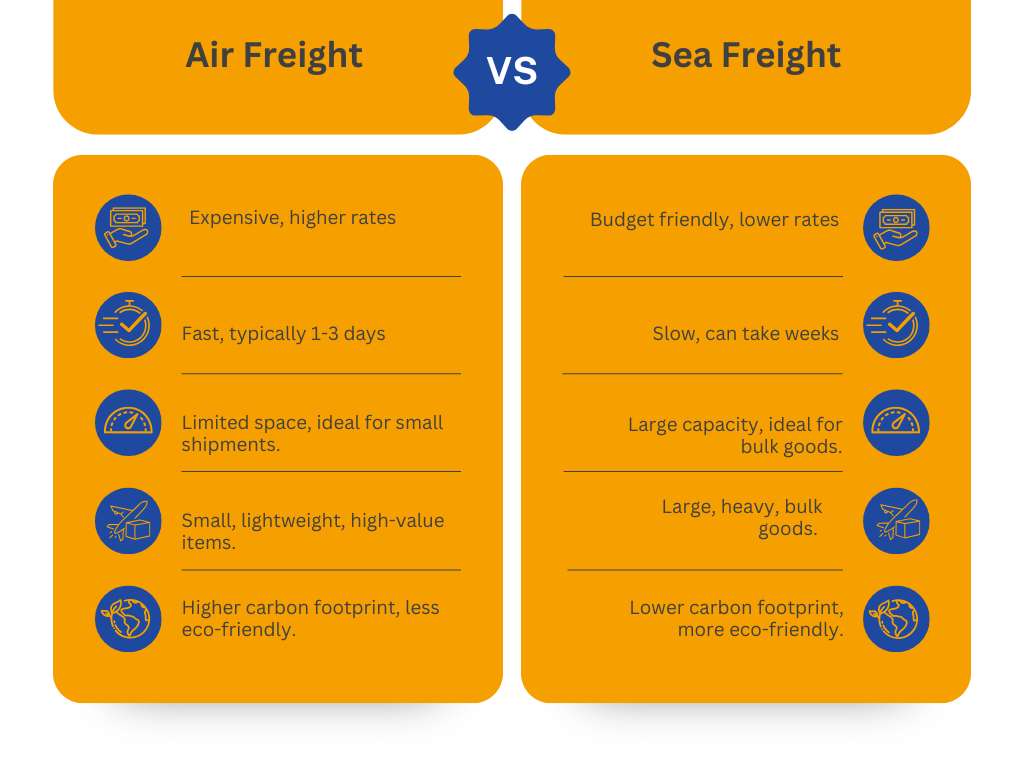When it comes to global shipping, the choice between air freight and sea freight isn’t just about moving goods; it’s about balancing speed, cost, and efficiency. Should you go with air or sea freight? Need to ship products quickly? Or are you working with bulk cargo on a budget? Understanding the key differences between air and sea freight can help you make smarter, more cost effective logistics decisions.
What Air Freight and Sea Freight
Air freight refers to the transportation of goods via airplanes, offering fast, secure delivery, especially for smaller high-value items. Sea freight, on the other hand, involves shipping goods in large containers by sea, making it deal for bulk shipments that can handle longer transit times.
Whether you’re comparing air freight, sea freight options for time-sensitive deliveries, or evaluating the advantages of air freight as compared to sea freight for your industry, choosing the right mode can directly impact your business performance.
Key Differences Between Air and Sea Freight
Speed (Air or Sea Freight)
In the debate of air vs sea freight, speed is where air clearly dominates. Air freight can deliver goods in just 1-3 days, whereas sea freight can take several weeks, depending on the route and port processing times. When your delivery timelines are tight, air freight vs sea freight becomes an easy decision, air wins hands down.
In today’s world, quicker delivery times are becoming the norm across many industries. But before you rush to ship everything by air, it’s worth taking a step back. Thoughtfully planning your shipping strategy, whether using sea freight for bulkier, non-urgent shipments or opting for air freight when speed is critical, can help create long term efficiencies and save your business money. So, while air freight offers incredible speed, don’t forget the value of sea freight when you’ve got time on your side.
Cost
When comparing sea freight vs. freight on price, sea freight emerges as the more affordable option, especially for heavy or large-volume cargo. Air freight is typically more expensive due to fuel costs, airport fees, and limited cargo space, but it’s justified for high value or time-critical shipments.
For businesses looking to cut down logistics expenses, sea freight offers an economical solution, particularly for long term or scheduled restocking. but in time sensitive industries like fashion or tech, the advantages of air freight as compared to sea freight are worth the premium.
On the other hand, sea freight is the budget friendly champion, especially for large shipments. It’s perfect for bulk cargo, heavy goods, and non-urgent deliveries. Though it takes longer – sometimes weeks – its cost effectiveness makes it ideal for businesses looking to move large volumes without breaking the bank.
Capacity and Cargo Type (Air or Sea freight)
Air vs. ocean freight differs greatly in terms of capacity. Cargo planes have limitations in volume and weight, making air freight suitable only for small and lightweight items such as electronics, luxury goods, or pharmaceuticals
Meanwhile, sea freight excels in bulk movement. Shipping containers allow businesses to move heavy machinery, raw materials, or large product inventories efficiently. If you’re deciding between air or sea freight for heavy or oversized items, sea freight is the clear choice.
Environment Impact
When considering the sea freight or air freight carbon footprint, sea freight is generally the greener option. Airplanes burn fuel at much higher rates, producing more greenhouse gases per shipment
For businesses prioritizing sustainability, reducing the air vs sea freight carbon footprint is crucial. Sea freight aligns better with eco-conscious goals, especially for companies committed to long-term environmental strategies.

Which One to Choose: Air or Sea Freight
The right choice between air and sea freight depends entirely on your shipping priorities.
On the other hand, sea freight shines when it comes to moving large volumes of bulk goods at a lower cost, making it ideal for businesses focused on cost efficiency. Businesses selling furniture, home décor, non-perishable food items will typically choose sea freight for bulk inventory replenishment or for products that don’t need immediate delivery. Sea freight is suited for industries with heavy machinery construction materials, or automotive parts.
In summary, air freight is ideal for fast-moving, high demand products that need to reach customers quickly, while sea freight is more suited for bulk shipments, offering cost savings for businesses that can plan for longer transit times.
Both methods have their place, and a smart mix of both can help optimise your logistics strategy based on your business goals and customer expectations.
Air Freight vs Sea Freight: Final Thoughts
So, which is better, air freight or sea freight? There’s no one-size-fits-all answer. By understanding the key differences in air vs sea freight, businesses can better align shipping methods with their operational needs and customer demands.
A strategic blend of air freight and sea freight offers the best of both worlds. Use air freight for speed and agility, and sea freight for volume and budget savings. Weigh the advantages of air freight compared to sea freight alongside your goals to create a resilient, flexible logistics approach.
Whether you’re comparing air vs ocean freight for your next shipment or evaluating the environmental impacts of air freight sea freight, making informed decisions can boost efficiency and profitability in global trade.
FAQs
Air freight is much faster, often delivering goods within a day or two, while sea freight can take weeks depending on the distance and shipping route.
Sea freight is generally more cost-effective, especially for large, bulky shipments. Air freight tends to be more expensive due to faster delivery speeds and fuel costs.
Air freight is best for urgent, time-sensitive, or high-value shipments where speed justifies the higher cost.
Sea freight is generally more eco-friendly as it emits lower greenhouse gases compared to air freight.









